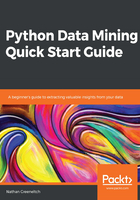
上QQ阅读APP看书,第一时间看更新
Recommended libraries
If you choose to manage a smaller environment than the full bundle from Anaconda, I recommend the following essential libraries for data mining. They will be used throughout this book:
- numpy: The fundamental math library for Python. Brings with it the numpy array data structure.
- scipy: Provides science and engineering routines built on the base of the numpy array. This library also has some good statistical functions.
- pandas: Offers relational data tables for storing, labeling, viewing, and manipulating data. You will never look at an array of numbers in the same way for the rest of your career after you've gotten comfortable with pandas and its popular data structure, called a dataframe.
- matplotlib: Python's core visualization library with line and scatter plots, bar and pie charts, histograms and spectrograms, and so on.
- seaborn: As statistical visualization library. Built on top of matplotlib and much easier to use. You can build complicated visual representations with, in many cases, a single line of code. This library takes pandas dataframes as input.
- statsmodels: Library focused on statistics functions and statistical testing. For example, it has a .summary() function that returns helpful summary stats and information about a model you've applied.
- scikit-learn: Python's workhorse machine learning library. It is easy to use and is maintained by an army of developers. The best part is the documentation on http:\\scikit-learn.org . It is so extensive that one could learn the field of machine learning just by reading though the entirety of it.
Editorial: Python has become ubiquitous in the fields of advanced data analysis in the last decade. This is partially due to the scripting nature of the language and approachability to non-programmers, but that is not the whole story. The pandas, scikit-learn, and seaborn libraries are essential to Python's growth in this domain. The power, ease-of-use, well-defined targeted scope, and open source nature of these three libraries are unmatched among free or paid packages. I recommend you learn them inside and out as you embark on a career in data mining.